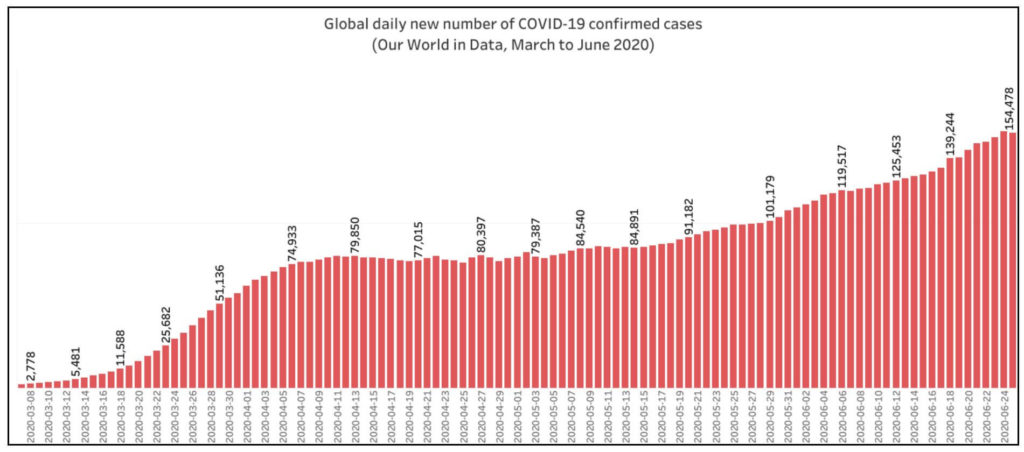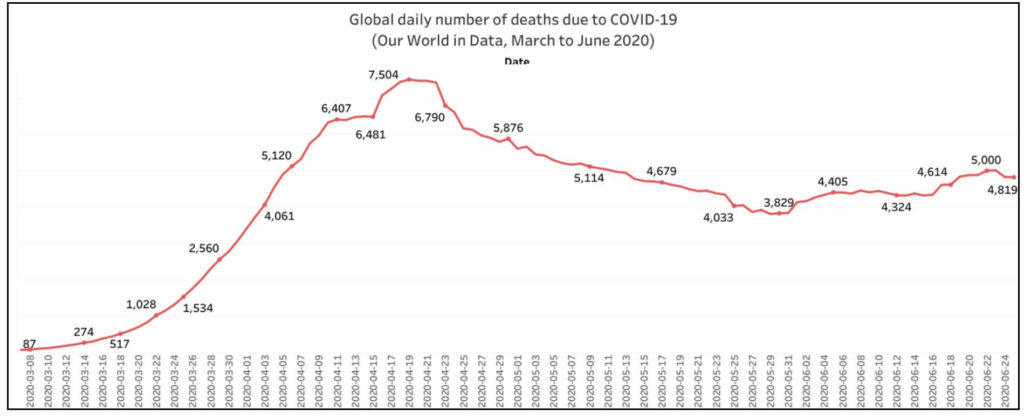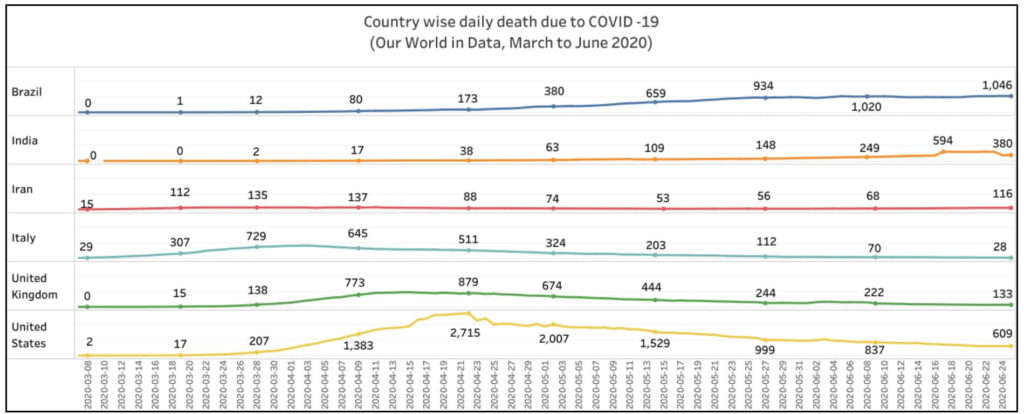While the number of new COVID-19 cases reported daily across the globe increases with every passing day, the number of daily deaths has decreased. We look at the data to see if there are any definite trends.
In December 2019, the first case of COVID-19 was reported in the Wuhan province in China. Since then, the viral respiratory infection has spread rapidly to all parts of the world, pushing countries to take strict measures such as lockdowns. The number of persons infected has been on a rise and is close to the one crore mark, while the number of deaths due to the pandemic is close to 5 Lakh as on 28 June 2020. The WHO has repeatedly asked countries to carry out widespread testing, and also adopt measures such as case finding, isolation, contact tracing, and respectful care. Research is still ongoing about the virus while efforts are on to find a vaccine.
About the data used in this story: Data used in this story is the seven-day moving average so as to adjust the stark variations in data reported each day. There can be variations in the time of reporting across countries, administrative delays, etc., which could impact the data. The data has been taken from ourworldindata.org website. Further, comparison of country wise data is purely based on data reported by these respective countries. It has to noted that the data reported by each country is dependent on multiple factors including testing strategies.
Number of cases reported daily is on the rise
The WHO declared COVID-19 a global pandemic on 11 March 2020. By then, over 1.2 lakh people were infected and 4,293 lives were claimed as per official data. However, the number of confirmed cases has been steadily rising as the virus is highly contagious. It took 68 days from 31 December 2019, for the number of cases to cross one lakh. The rate has increased substantially ever since. Globally, it took 12 days for the total number of cases to cross 2 lakh, and just 5 days to cross the three-lakh mark. Towards the end of May, one lakh cases were getting reported on a daily basis. The number of confirmed cases reported each day globally from 1 March 2020 to 26 June 2020 is represented in the following chart. On 26 June 2020 alone, more than 1.5 lakh cases were reported. The increase in numbers is also due to the increased testing across countries.

Daily deaths due to COVID-19 have decreased
While the number of daily new cases is on a continuous rise, the number of daily deaths due to COVID-19 shows a contrasting trend. The total number of deaths crossed one lakh in 102 days after 31 December 2019, from when the data is being reported daily by the WHO. It took around 16 days for the total deaths to touch 2 lakh, 19 days to cross 3 lakh, 24 days to cross 4 lakh deaths. The number of deaths reported daily witnessed a peak in mid-April. At the peak, over 7,500 lives were claimed by the pandemic every day, as per WHO data. Since then, this number has reduced to almost half the peak of around 3,829 deaths a day by end of May. However, the number has since increased again. Currently, between 4500 and 5000 deaths are reported every day from across the world, much less than the peak witnessed in mid-April. The difference in the daily trend of new cases and deaths is clearly visible.

US and Iran are witnessing a second wave while cases keep rising in India and Brazil
Brazil, India, Iran, Italy, UK, and US are some of the worst affected countries in terms of number of people who contracted the disease. Most of these countries have long crossed the number of cases reported in China earlier. Brazil and India are recording higher number of cases each day whereas Italy and UK have managed to ‘flatten the curve’. At the same time, in USA and Iran, the number of cases reported increased initially and then came down gradually. However, both the countries are currently witnessing a second peak of infection and are reporting record number of new cases daily.

Fatality rate in India is the least among the six worst affected countries
While India & Brazil are reporting an increased number of cases every day, the case fatality rates in these two countries is lower than that in the rest. The case fatality rate in India is the least among these countries and is around 3.1% while that in Italy and UK is more than 14%. Brazil’s fatality rate is 4.7% while that in US is more than 5%. Case Fatality Rate (CFR) is defined as number of deaths divided by the total number of cases.
Italy which has a high CFR, reported more than 800 deaths daily in the beginning of April. But the number has fallen substantially since then. A similar trend is observed in the UK too, though the peak was recorded in the latter half of April.
Number of deaths reported daily in US and Iran is lower than before
US witnessed a peak in number of daily deaths around mid-April while the peak was in late-March in Iran. The number of daily deaths decreased after the peak with both US and Iran reporting fewer deaths now even though the number of new daily cases is increasing.
Health infrastructure such as bed availability, protection kits, etc. in has improved in most countries in last few months. Multiple drugs/medicines used for other illnesses are now being used in specific COVID-19 cases. All this may be contributing to fewer deaths compared to the last few months.

The official data on daily cases does not reflect the actual infection rate
The data reported by various countries is a severe under-estimate of the actual infection rate. This is because of testing strategy followed by various countries where only symptomatic and the direct contacts of infected persons are tested. Sero-surveys and antibody tests in various countries have confirmed this. Antibodies study from Spain indicated that the actual infection rate could be 10 times the officially reported number. Even the CDC of USA has stated that the original number of cases can be ten times the reported ones in US. Even in India, the sero-surveys commissioned by ICMR indicate an infection rate anywhere from 1%. Similar surveys indicated an infection rate of around 14% in Kolkata. All this could mean that the fatality rates across the world could be much lower since the actual infection rates are almost 10 times the reported number. However, there are complaints that the deaths due to COVID-19 are also being under-reported, especially in countries with very high number of cases.
Some Italian doctors and scientists claim that the coronavirus is losing its potency
Scientists have reportedly claimed that the virus is losing its virulence. According to the New York Post, Dr. Matteo Bassetti, an Italian infectious diseases doctor said that the virus seems to have become less potent, possibly due to genetic mutations. He added that, in March and early April, people came to hospitals with severe illness and required oxygen and ventilator, while some developed pneumonia. However, since April, the doctor claimed that even elderly patients are sitting up in beds and breathing without any help. According to him, mutation is the response of the virus to social distancing measures and the use of masks. Eventually, it is possible that the virus will be eradicated before researchers find a vaccine.
WHO brushed of the claim stating it lacked scientific evidence
Even though studies suggest that pathogenicity of viruses weaken with mutations, it has not been proved in the case of SARS- COV- 2, the virus causing COVID-19. WHO has stated that there is no data to show that the virus is weakening. Further, they mentioned that the scientist’s claim lacked scientific evidence, and that the disease is still fatal since there has been no change in terms of transmissibility or severity of the coronavirus. The virus needs to be respected & feared since there is no vaccine and it is very contagious. For now, the most efficient way to tackle the pandemic is by practicing social distancing, wearing masks, practicing respiratory hygiene, and washing hands regularly.


